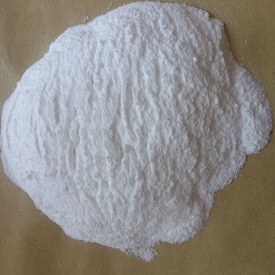Dibortrioxid Chemische Eigenschaften,Einsatz,Produktion Methoden
ERSCHEINUNGSBILD
FARBLOSE, GERUCHLOSE, HYGROSKOPISCHE, SPR?DE, GLASARTIGE ODER HARTE WEISSE KRISTALLE MIT LEICHT BITTEREM GESCHMACK.
CHEMISCHE GEFAHREN
Reagiert langsam mit Wasser unter Bildung von Bors?ure. Greift Metall in Gegenwart von feuchter Luft an.
ARBEITSPLATZGRENZWERTE
TLV: 10 mg/m?(als TWA); (ACGIH 2005).
MAK: IIb (nicht festgelegt, aber Informationen vorhanden) (DFG 2008).
AUFNAHMEWEGE
Aufnahme in den K?rper durch Inhalation des Aerosols und durch Verschlucken.
INHALATIONSGEFAHREN
Verdampfen bei 20°C vernachl?ssigbar; eine bel?stigende Partikelkonzentration in der Luft kann jedoch beim Dispergieren schnell erreicht werden.
WIRKUNGEN BEI KURZZEITEXPOSITION
WIRKUNGEN BEI KURZZEITEXPOSITION: Die Substanz reizt die Augen, die Haut und die Atemwege.
LECKAGE
Verschüttetes Material in Beh?ltern sammeln; falls erforderlich durch Anfeuchten Staubentwicklung verhindern. Reste sorgf?ltig sammeln. An sicheren Ort bringen. Pers?nliche Schutzausrüstung: Atemschutzger?t, P1-Filter für inerte Partikel.
R-S?tze Betriebsanweisung:
R36/37/38:Reizt die Augen, die Atmungsorgane und die Haut.
S-S?tze Betriebsanweisung:
S26:Bei Berührung mit den Augen sofort gründlich mit Wasser abspülen und Arzt konsultieren.
S37/39:Bei der Arbeit geeignete Schutzhandschuhe und Schutzbrille/Gesichtsschutz tragen.
Chemische Eigenschaften
Boron oxide is a noncombustible, colorless, semitransparent lumps or hard, white, odorless crystals, with slightly bitter taste.

Physikalische Eigenschaften
Colorless glassy solid or vitreous crystal; hexagonal crystal system; slightly bitter taste; hygroscopic; density 2.55 g/cm
3; melts at 450°C; vaporizes at 1,500°C; slightly soluble in cold water (3.3%), soluble in alcohol and boiling water (20%).
Verwenden
Boron oxide was used as the intermediate glass layer at a bonding temperature of 450°C. In preparation of fluxes; component of enamels and glass; catalyst in organic reaction.
In metallurgy; in analysis of silicates to determine SiO2 and alkalies; in blowpipe analysis.
synthetische
Boric oxide is produced by treating borax with sulfuric acid in a fusion furnace. At temperatures above 750°C, the molten boric acid layer separates out from sodium sulfate. It then is decanted, cooled, and obtained in 96-97% purity. Boric acid above 99% purity may be obtained by fusing granular material.
Boric oxide may be prepared by heating boric acid.
2B(OH)
3 → B2O
3 + 3H
2O
Vorbereitung Methode
Boric oxide is produced by thermal fusion of boric acid,
forming a clear transparent glass-like solid that is subsequently
ground into white vitreous granules. It is used
principally in the manufacture of glass and vitreous
products.
Allgemeine Beschreibung
Colorless, semi-transparent glassy lumps or hard white odorless crystals. Mp 450°C; bp: 1860°C. Density: 2.46 g cm-3. Moderately soluble in water. Used as an insecticide; as the starting material for the synthesis of other boron compounds; as a fluxing agent in enamels and glasses; and in mixture with 2-6% boron nitride, as a bonding agent in the hot isostatic pressing of boron nitride ceramics.
Reaktivit?t anzeigen
Boron oxide is non-combustible. Of generally low chemical reactivity. Reacts exothermically but slowly with water to form boric acid, a weak acid. Reacts exothermically with strong bases. May react with strong reducing agents such as metal hydrides, metal alkyls to generate flammable or explosive gases. May react violently on contact with bromine pentafluoride. Corrosive to metals in the presence of air.
Hazard
Eye and upper respiratory tract irritant.
Health Hazard
Boron oxide is an eye and respiratory irritant. In 113 workers exposed to boron oxide and boric acid dusts, there were statistically significant increases in symptoms of eye irrita- tion; dryness of the mouth, nose, and throat; sore throat; and productive cough compared with controls. The mean exposure level was 4.1mg/m3 , with a range of 1.2–8.5mg/m3 . Exposures may occasionally have exceeded 10 mg/m3 . Because of mixed exposures, the study does not indicate whether boron oxide or boric acid dust is more important in causing symp- toms, nor does it indicate the minimum duration of exposure necessary to produce symptoms.
Excessive absorption of boron oxide may lead to cardiovascular collapse, alterations in temperature regulation, and coma.
m?gliche Exposition
Boron oxide is used in glass manufacture
and the production of other boron compounds. It is
used in fluxes, enamels, drying agents, and as a catalyst.
Versand/Shipping
UN3077 Environmentally hazardous substances,
solid, n.o.s., Hazard class: 9; Labels: 9—Miscellaneous
hazardous material, Technical Name Required.
Inkompatibilit?ten
Incompatible with bromine pentafluoride,
calcium oxide. Reacts slowly with water, forming boric acid.
Reacts exothermically with alkaline material and strong
bases. May react with strong reducing agents such as metal
hydrides, metal alkyls to generate flammable or explosive
gases. May react violently on contact with bromine pentafluoride.
Corrosive to metals in the presence of air.
Dibortrioxid Upstream-Materialien And Downstream Produkte
Upstream-Materialien
Downstream Produkte

